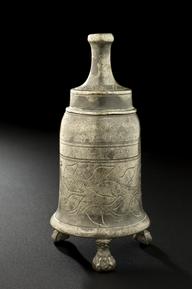


Glass nipple shield, second half 19th century
This glass example of a nipple shield, seen on the right, is alongside a lead one (A627128/1) on the left. It originally had a rubber teat covering the glass tip. This protected the child’s mouth from the glass. Doctors of the period advised breastfeeding was best for infants. They said babies should be breastfed by the mother if possible, or a wet nurse of ‘good moral character’. Dried milk and condensed milk were introduced in the 1860s. However, doctors claimed milk substitutes caused diarrhoea, indigestion and rickets when fed to babies.
Nipple shields protect nipples from teething babies. They also soothe sore nipples of breastfeeding mothers. They prevent nipples from flattening, contain leaking milk and help women who had trouble breastfeeding. Nipple shields of the Victorian period were never popular with mothers. They were often made of seemingly inappropriate materials such as lead and glass.
Details
- Category:
- Nursing & Hospital Furnishings
- Collection:
- Sir Henry Wellcome's Museum Collection
- Object Number:
- A500005
- Materials:
- whole, glass
- Measurements:
-
overall: 51 mm 53 mm, .01kg
- type:
- nipple shield




